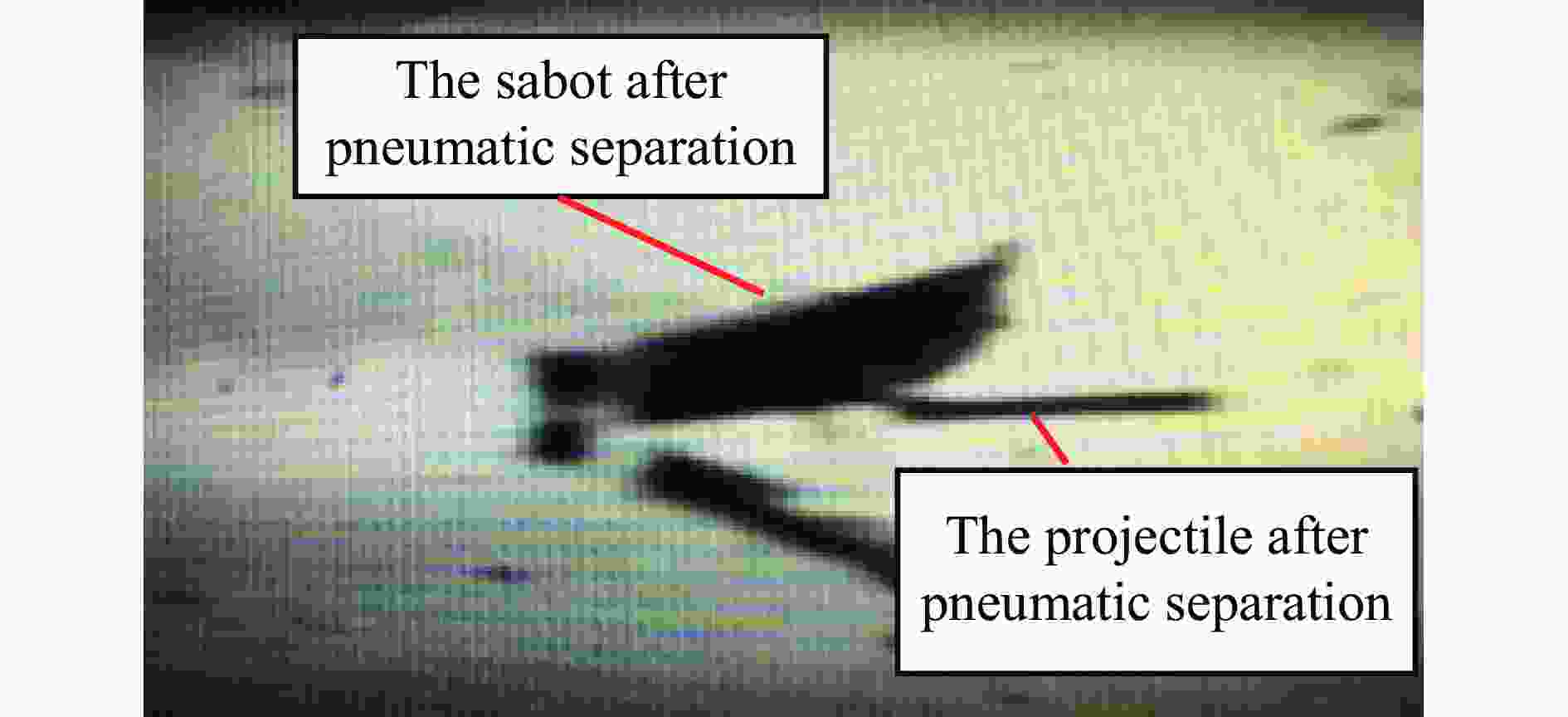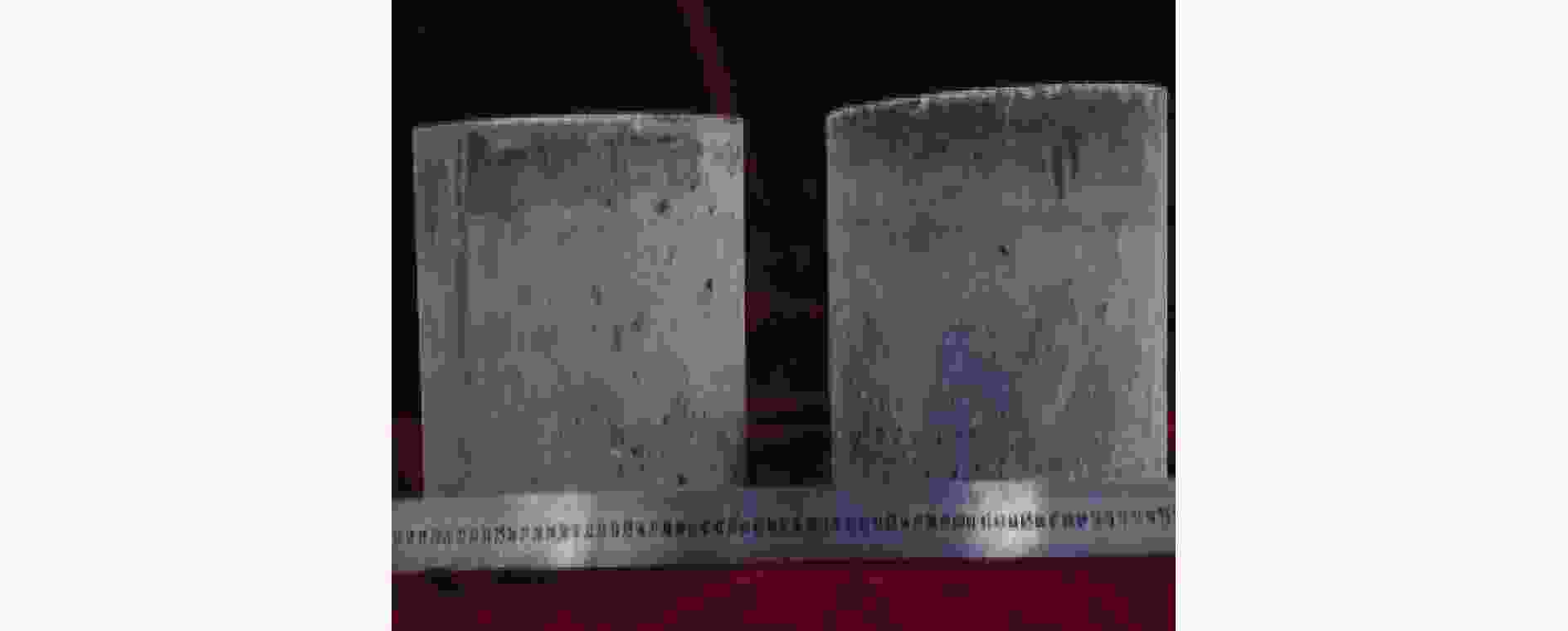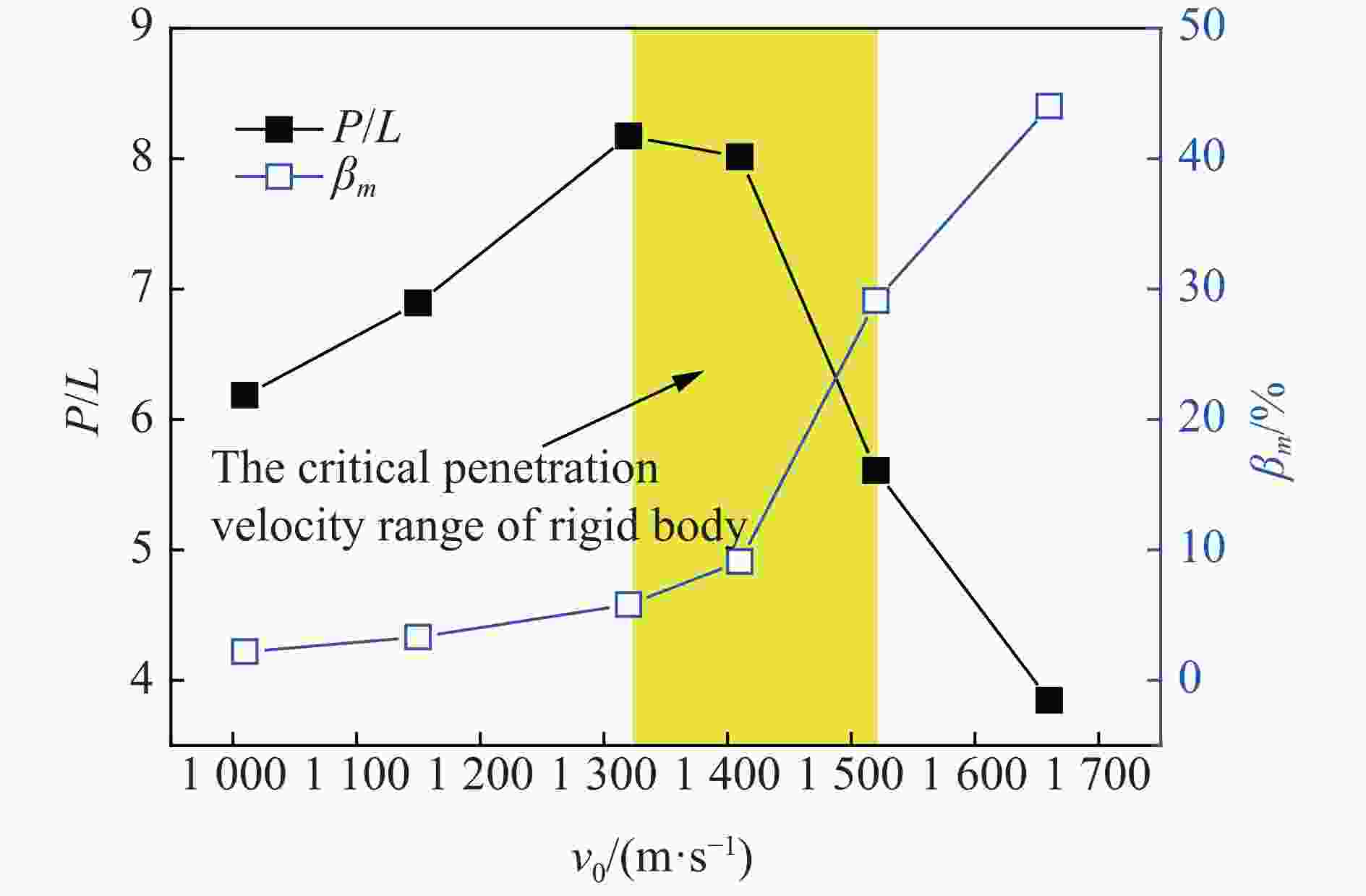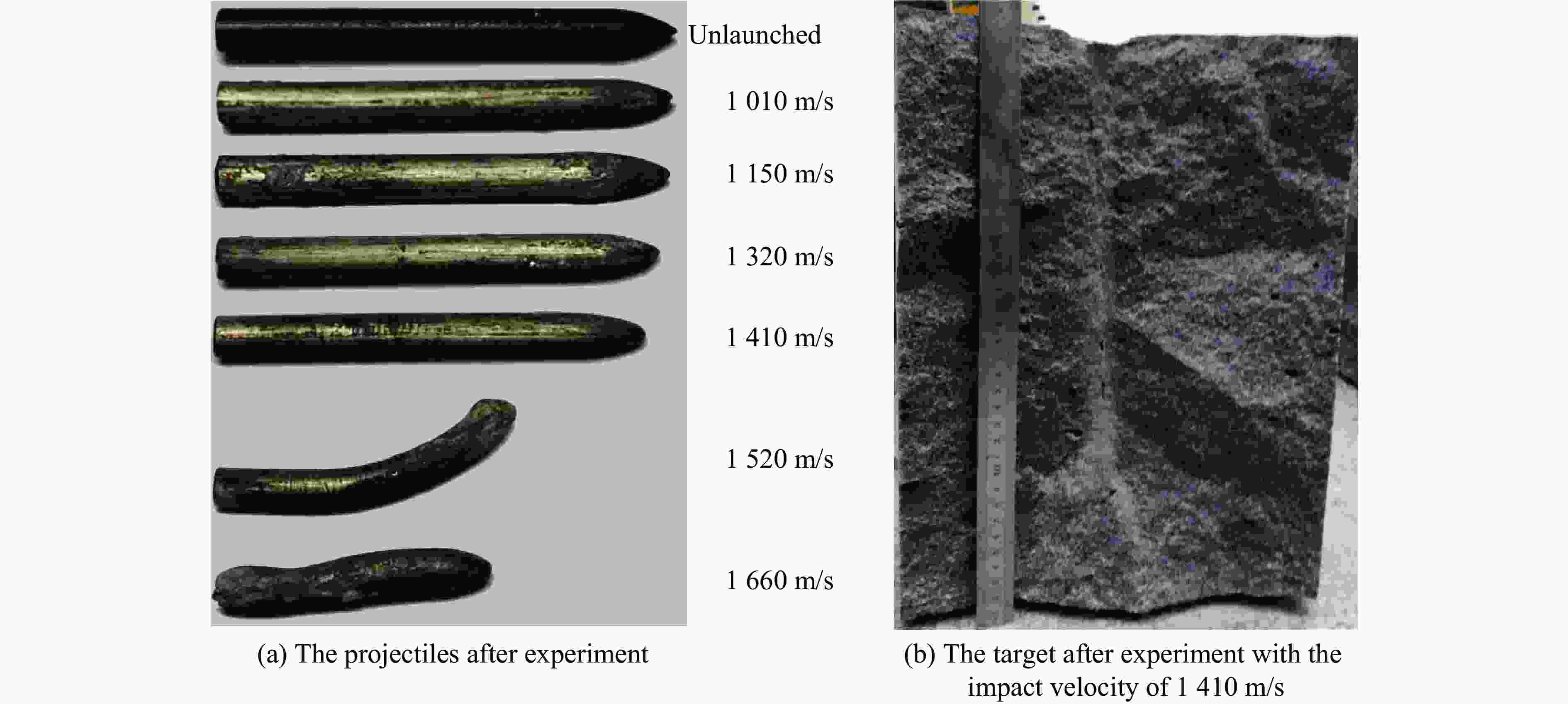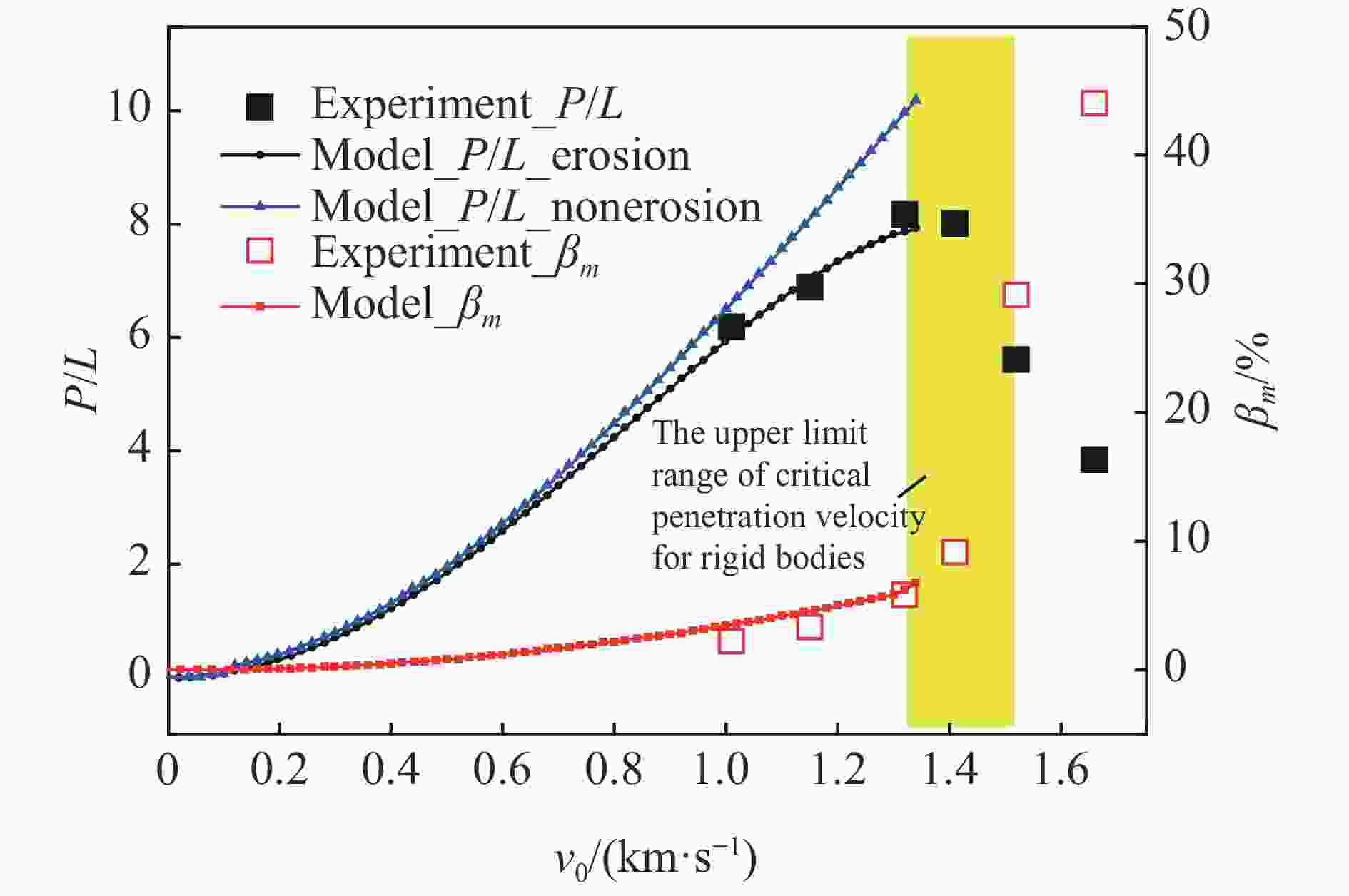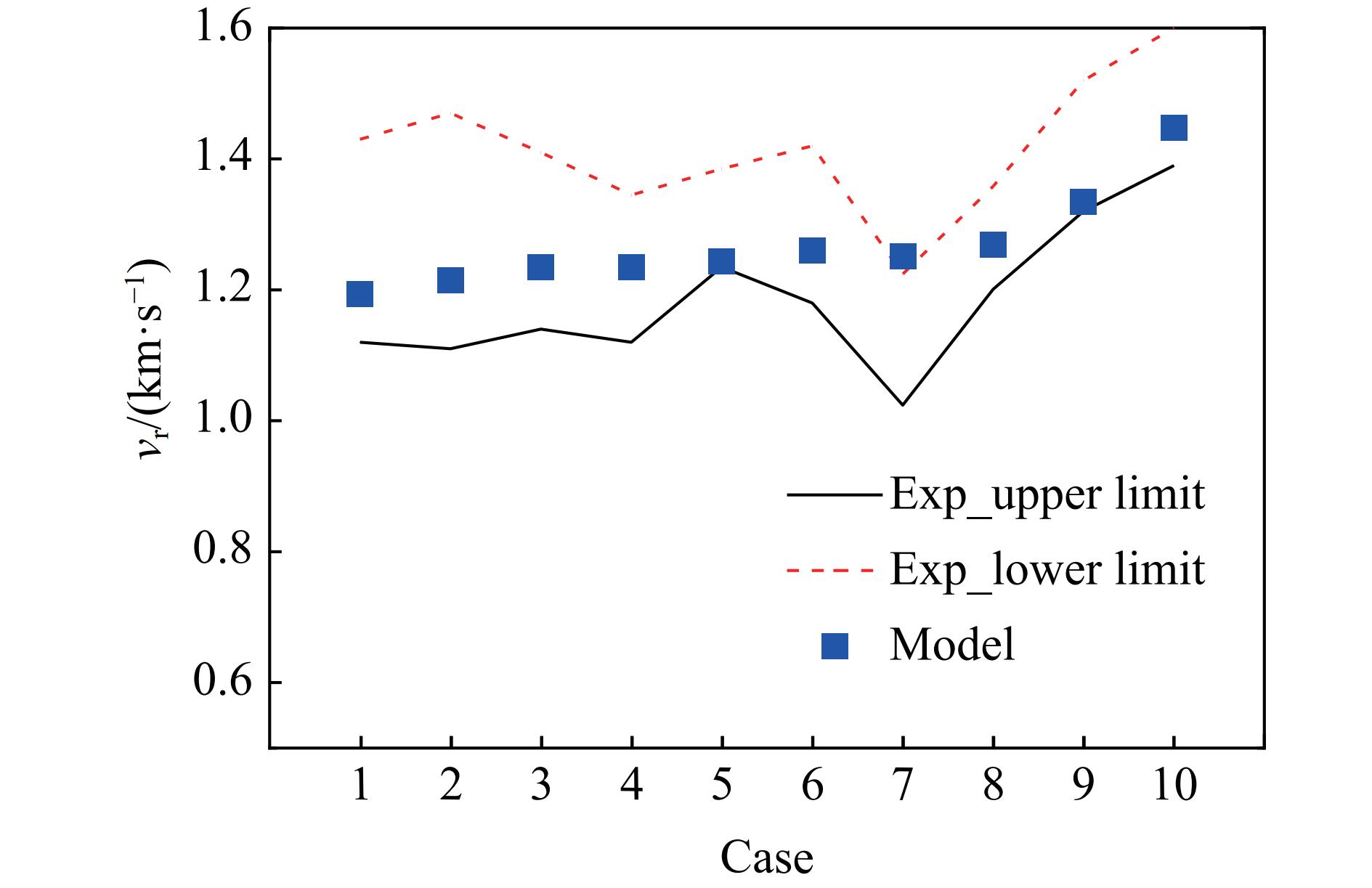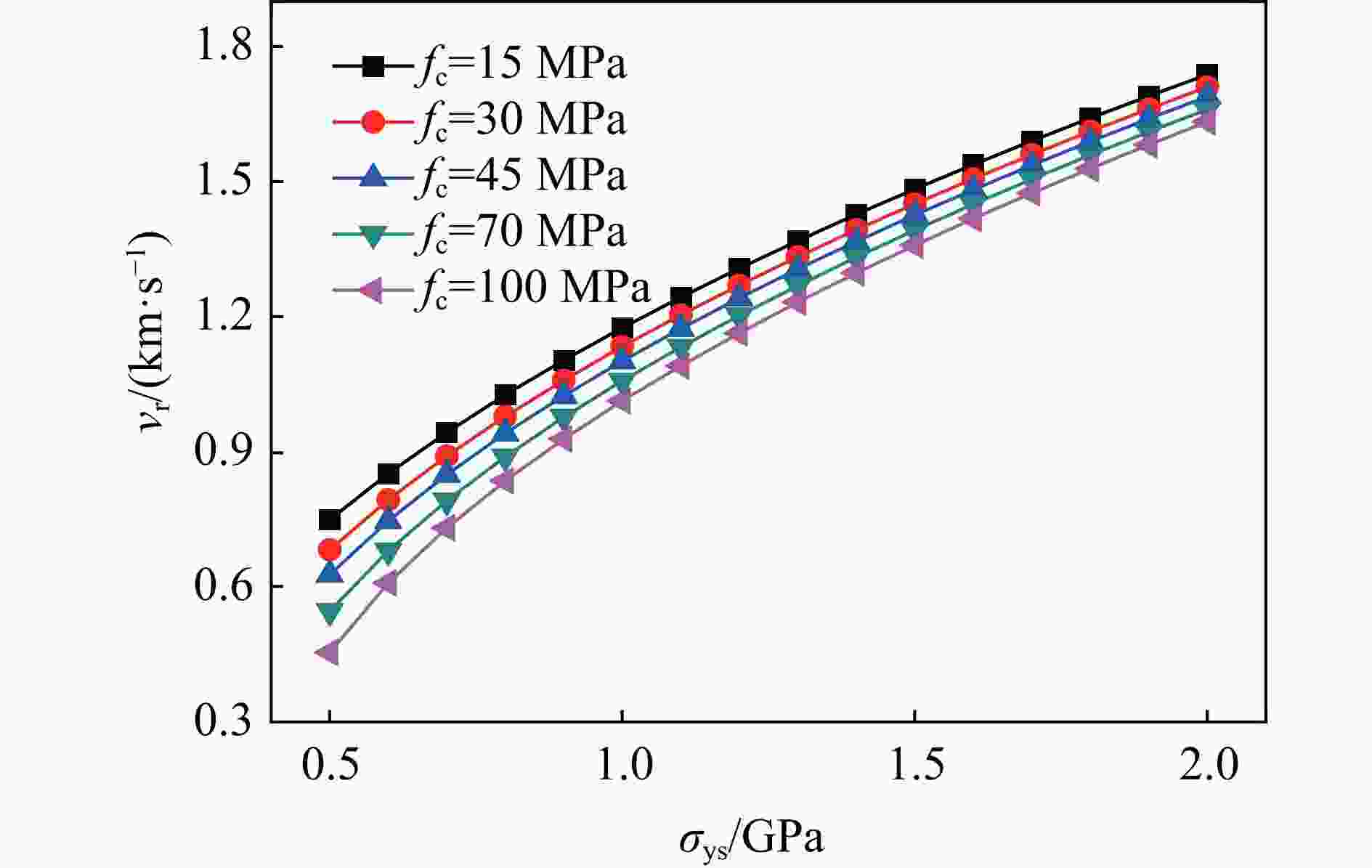Rigid-body critical transformation velocity of a high-strength steel projectile penetrating concrete targets at high velocities
-
摘要: 刚体临界侵彻速度的理论准确预测是高强钢弹体高速侵彻混凝土靶研究中的关键问题,本文中利用二级轻气炮开展了克级高强钢(G50)卵形头长杆弹以
1010 ~1660 m/s的速度侵彻C40混凝土靶实验研究,获取了刚体临界侵彻速度和侵彻深度实验数据,并开展了刚体临界侵彻速度和考虑弹体头部磨蚀的侵彻深度理论分析,得到结论如下:(1)克级G50卵形头长杆弹侵彻C40混凝土靶时的刚体临界侵彻速度区间为1320 ~1520 m/s;(2)基于已有侵彻模型,建立了新的刚体临界侵彻速度理论模型,模型计算结果与本文及文献中的系列实验结果吻合较好;(3)建立了考虑头部侵蚀的侵彻深度模型,与实验结果吻合较好;(4)弹体屈服强度对刚体临界侵彻速度有显著影响,靶体无围压抗压强度对刚体临界侵彻速度有较小影响,实验前的弹体头形系数和弹体尺寸对刚体临界侵彻速度无显著影响。Abstract: The accurate prediction of the critical penetration speed of a rigid body is a key issue in the study of high-strength steel projectile penetration into concrete targets at high velocities. This paper conducts experimental research on the penetration of C40 concrete targets by high-strength steel (G50) ogive-nosed long rod projectiles at the velocities of1010 to1660 m/s using a two-stage light gas gun, obtaining experimental data on the critical penetration velocity and penetration depth of the rigid body. Theoretical analysis of the critical penetration velocity of the rigid body and the penetration depth considering the projectile head erosion is also carried out, and the following conclusions are drawn: (1) the interval of the critical penetration velocity for G50 ogive-nosed long rod projectiles penetrating C40 concrete targets is1320 to1520 m/s; (2) based on existing penetration models, a new theoretical model for the critical penetration velocity of the rigid body was established, and the calculated results of the model are in good agreement with the experimental results of this paper and the literature; (3) a penetration depth model considering head erosion was established, which also matches the experimental results well; (4) the yield strength of the projectile has a significant effect on the critical penetration velocity of the rigid body, the unconfined compressive strength of the target has a minor effect on the critical penetration velocity, and the shape coefficient and size of the projectile before the experiment have no significant effect on the critical penetration velocity. -
表 1 高速侵彻实验结果
Table 1. High-velocity penetration experiment results
实验编号 ν0/(m∙s−1) P/mm Lpr/mm βL/% mpr/g βm/% 1 1 010 193 30.30 2.8 1.70 2.2 2 1 150 215 30.00 3.9 1.67 3.3 3 1 320 255 28.70 10.6 1.62 5.8 4 1 410 250 29.28 8.8 1.56 9.1 5 1 520 175 20.90 33.0 1.22 29.1 6 1 660 120 14.77 54.0 0.96 44.0 表 2 不同弹靶组合得到的刚体临界侵彻速度实验值与计算值的对比
Table 2. Comparison of experimental and calculated critical rigid-body penetration velocities obtained by different projectile-target combinations
编号 ψ 弹体材料 σys/MPa m0/g fc/MPa vr/(m∙s−1) 实验 计算 Case 1[4] 4.25 60Si2Mn 1200 ~150 76.4 1120 ~1430 1194 Case 2[4] 4.25 60Si2Mn 1200 ~150 61.3 1110 ~1470 1215 Case 3[4] 4.25 60Si2Mn 1200 ~150 48.6 1140 ~1410 1235 Case 4[4] 9.25 60Si2Mn 1200 ~150 48.6 1120 ~1345 1235 Case 5[4] 4.25 35CrMnSi 1275 ~150 76.4 1235 ~1385 1244 Case 6[4] 4.25 60Si2Mn 1200 ~150 34.8 1180 ~1420 1260 Case 10[4] 4.25 40CrNiMo 1610 ~150 76.4 > 1390 1448 Case 7[1] 4.25 4340钢 1258 478 62.8 1024 ~1224 1251 Case 8[1] 4.25 4340钢 1258 1600 51 1201 ~1358 1269 Case 9本文 3 G50 1340 1.72 42.7 1320 ~1520 1335 -
[1] FORRESTAL M J, FREW D J, HANCHAK S J, et al. Penetration of grout and concrete targets with ogive-nose steel projectiles [J]. International Journal of Impact Engineering, 1996, 18(5): 465–476. DOI: 10.1016/0734-743X(95)00048-F. [2] 武海军, 张爽, 黄风雷. 钢筋混凝土靶的侵彻与贯穿研究进展 [J]. 兵工学报, 2018, 39(1): 182–208. DOI: 10.3969/j.issn.1000-1093.2018.01.020.WU H J, ZHANG S, HUANG F L. Research progress in penetration/perforation into reinforced concrete targets [J]. Acta Armamentarii, 2018, 39(1): 182–208. DOI: 10.3969/j.issn.1000-1093.2018.01.020. [3] 武海军, 黄风雷, 王一楠. 高速弹体非正侵彻混凝土试验研究 [C]//第八届全国爆炸力学学术会议论文集. 吉安: 中国力学学会爆炸力学专业委员会, 2007: 495–501.WU H J, HUANG F L, WANG Y N. Experimental study on high-velocity non-positive penetration concrete [C]//Proceedings of the 8th National Conference on Explosive Mechanics. Ji’an, Jiangxi: Explosive Mechanics Professional Committee of the Chinese Society of Mechanics, 2007: 495–501. [4] 何翔, 徐翔云, 孙桂娟, 等. 弹体高速侵彻混凝土的效应实验 [J]. 爆炸与冲击, 2010, 30(1): 1–6. DOI: 10.11883/1001-1455(2010)01-0001-06.HE X, XU X Y, SUN G J, et al. Experimental investigation on projectiles' high-velocity penetration into concrete targets [J]. Explosion and Shock Waves, 2010, 30(1): 1–6. DOI: 10.11883/1001-1455(2010)01-0001-06. [5] 王明洋, 李杰, 李海波, 等. 岩石的动态压缩行为与超高速动能弹毁伤效应计算 [J]. 爆炸与冲击, 2018, 38(6): 1200–1217. DOI: 10.11883/bzycj-2018-0173.WANG M Y, LI J, LI H B, et al. Dynamic compression behavior of rock and simulation of damage effects of hypervelocity kinetic energy bomb [J]. Explosion and Shock Waves, 2018, 38(6): 1200–1217. DOI: 10.11883/bzycj-2018-0173. [6] 李干, 宋春明, 邱艳宇, 等. 超高速弹对花岗岩侵彻深度逆减现象的理论与实验研究 [J]. 岩石力学与工程学报, 2018, 37(1): 60–66. DOI: 10.13722/j.cnki.jrme.2017.0584.LI G, SONG C M, QIU Y Y, et al. Theoretical and experimental studies on the phenomenon of reduction in penetration depth of hyper-velocity projectiles into granite [J]. Chinese Journal of Rock Mechanics and Engineering, 2018, 37(1): 60–66. DOI: 10.13722/j.cnki.jrme.2017.0584. [7] 赵晓宁. 高速弹体对混凝土侵彻效应研究 [D]. 南京: 南京理工大学, 2011.ZHAO X N. Study on the effect of projectiles high-velocity normal penetrating into concrete targets [D]. Nanjing: Nanjing University of Science and Technology, 2011. [8] KONG X Z, WU H, FANG Q, et al. Projectile penetration into mortar targets with a broad range of striking velocities: test and analyses [J]. International Journal of Impact Engineering, 2017, 106: 18–29. DOI: 10.1016/j.ijimpeng.2017.02.022. [9] 王可慧, 耿宝刚, 初哲, 等. 弹体高速侵彻钢筋混凝土靶的结构变形及质量损失的实验研究 [J]. 高压物理学报, 2014, 28(1): 61–68. DOI: 10.11858/gywlxb.2014.01.010.WANG K H, GENG B G, CHU Z, et al. Experimental studies on structural response and mass loss of high-velocity projectiles penetrating into reinforced concrete targets [J]. Chinese Journal of High Pressure Physics, 2014, 28(1): 61–68. DOI: 10.11858/gywlxb.2014.01.010. [10] CHEN X W, LI Q M. Transition from nondeformable projectile penetration to semihydrodynamic penetration [J]. Journal of Engineering Mechanics, 2004, 130(1): 123–127. DOI: 10.1061/(ASCE)0733-9399(2004)130:1(123). [11] 刘闯, 张先锋, 黄长强, 等. 半球头长杆弹高速侵彻半无限厚靶临界速度理论模型 [J]. 振动与冲击, 2019, 38(9): 8–14. DOI: 10.13465/j.cnki.jvs.2019.09.002.LIU C, ZHANG X F, HUANG C Q, et al. Critical velocity theoretical model for hemispherical long rod projectiles' penetrating semi-infinite thick target at high velocity [J]. Journal of Vibration and Shock, 2019, 38(9): 8–14. DOI: 10.13465/j.cnki.jvs.2019.09.002. [12] LIU C, ZHANG X F, CHEN H H, et al. Experimental and theoretical study on steel long-rod projectile penetration into concrete targets with elevated impact velocities [J]. International Journal of Impact Engineering, 2020, 138: 103482. DOI: 10.1016/j.ijimpeng.2019.103482. [13] 高飞, 张国凯, 纪玉国, 等. 卵形弹体超高速侵彻砂浆靶的响应特性 [J]. 兵工学报, 2020, 41(10): 1979–1987. DOI: 10.3969/j.issn.1000-1093.2020.10.007.GAO F, ZHANG G K, JI Y G, et al. Response characteristics of hypervelocity ogive-nose projectile penetrating into mortar target [J]. Acta Armamentarii, 2020, 41(10): 1979–1987. DOI: 10.3969/j.issn.1000-1093.2020.10.007. [14] 赵军, 陈小伟, 金丰年, 等. 考虑头形磨损变化的动能弹侵彻深度研究 [J]. 力学学报, 2010, 42(2): 212–218. DOI: 10.6052/0459-1879-2010-2-2009-009.ZHAO J, CHEN X W, JIN F N, et al. Studying on the penetration depth of penetrator with including the effect of mass abrasion [J]. Chinese Journal of Theoretical and Applied Mechanics, 2010, 42(2): 212–218. DOI: 10.6052/0459-1879-2010-2-2009-009. [15] LU Z C, WEN H M. On the penetration of high strength steel rods into semi-infinite aluminium alloy targets [J]. International Journal of Impact Engineering, 2018, 111: 1–10. DOI: 10.1016/j.ijimpeng.2017.08.006. [16] 卢正操, 张元迪, 文鹤鸣, 等. 长杆弹侵彻半无限混凝土靶的理论研究 [J]. 现代应用物理, 2018, 9(4): 040102. DOI: 10.12061/j.issn.2095-6223.2018.040102.LU Z C, ZHANG Y D, WEN H M, et al. Theoretical study on the penetration of long rods into semi-infinite concrete targets [J]. Modern Applied Physics, 2018, 9(4): 040102. DOI: 10.12061/j.issn.2095-6223.2018.040102. [17] ZHANG Y D, LU Z C, WEN H M. On the penetration of semi-infinite concrete targets by ogival-nosed projectiles at different velocities [J]. International Journal of Impact Engineering, 2019, 129: 128–140. DOI: 10.1016/j.ijimpeng.2019.03.004. [18] LAN B, WEN H M. Alekseevskii-Tate revisited: an extension to the modified hydrodynamic theory of long rod penetration [J]. Science China Technological Sciences, 2010, 53(5): 1364–1373. DOI: 10.1007/s11431-010-0011-x. [19] 姚志彦, 李金柱, 齐凯丽, 等. 长杆弹超高速侵彻砂浆靶临界速度的实验和计算 [J]. 兵工学报, 2022, 43(7): 1578–1588. DOI: 10.12382/bgxb.2021.0403.YAO Z Y, LI J Z, QI K L, et al. Experiment and calculation of critical velocity of long-rod projectile penetrating mortar target at hypervelocity [J]. Acta Armamentarii, 2022, 43(7): 1578–1588. DOI: 10.12382/bgxb.2021.0403. [20] 张德志, 唐润棣, 林俊德, 等. 新型气体驱动二级轻气炮研制 [J]. 兵工学报, 2004, 25(1): 14–18. DOI: 10.3321/j.issn:1000-1093.2004.01.004.ZHANG D Z, TANG R D, LIN J D, et al. Development of a new type gas-driven two-stage light gas gun [J]. Acta Armamentarii, 2004, 25(1): 14–18. DOI: 10.3321/j.issn:1000-1093.2004.01.004. [21] FORRESTAL M J, ALTMAN B S, CARGILE J D, et al. An empirical equation for penetration depth of ogive-nose projectiles into concrete targets [J]. International Journal of Impact Engineering, 1994, 15(4): 395–405. DOI: 10.1016/0734-743X(94)80024-4. [22] FORRESTAL M J, FREW D J, HICKERSON J P, et al. Penetration of concrete targets with deceleration-time measurements [J]. International Journal of Impact Engineering, 2003, 28(5): 479–497. DOI: 10.1016/S0734-743X(02)00108-2. [23] 何丽灵. 高速侵彻混凝土弹体的动力学行为研究:计及质量损失和头形钝化 [D]. 合肥: 中国科学技术大学, 2012.HE L L. Studies on dynamic behavior of high-speed projectile penetrating into concrete target: considering mass loss and nose blunting [D]. Hefei: University of Science and Technology of China, 2012. [24] TATE A. Further results in the theory of long rod penetration [J]. Journal of the Mechanics and Physics of Solids, 1969, 17(3): 141–150. DOI: 10.1016/0022-5096(69)90028-3. [25] 宋小龙, 安继儒. 新编中外金属材料手册 [M]. 北京: 化学工业出版社, 2012.SONG X L, AN J R. New Chinese and foreign metal materials manual [M]. Beijing: Chemical Industry Press, 2012. -






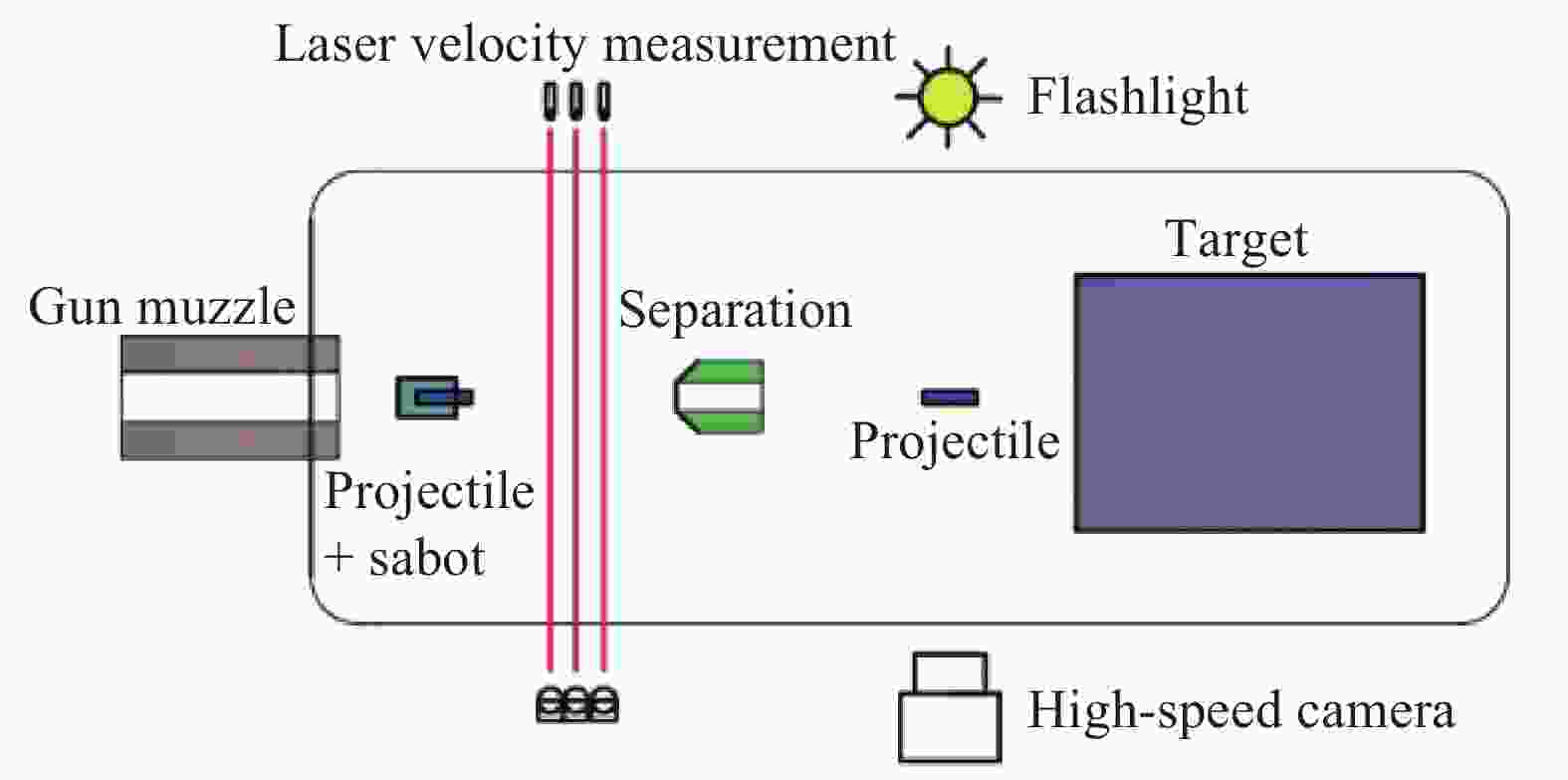
 下载:
下载:
